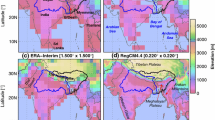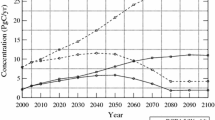Abstract
In this study, human-induced climate change over the Eastern Mediterranean–Black Sea region has been analyzed for the twenty-first century by performing regional climate model simulations forced with large-scale fields from three different global circulation models (GCMs). Climate projections have been produced with Special Report on Emissions Scenarios A2, A1FI and B1 scenarios, which provide greater diversity in climate information for future period. The gradual increases for temperature are widely apparent during the twenty-first century for each scenario simulation, but ECHAM5-driven simulation generally has a weaker signal for all seasons compared to CCSM3 simulations except for the Fertile Crescent. The contrast in future temperature change between the winter and summer seasons is very strong for CCSM3-A2-driven and HadCM3-A2-driven simulations over Carpathians and Balkans, 4–5 °C. In addition, winter runoff over mountainous region of Turkey, which feeds many river systems including the Euphrates and Tigris, increases in second half of the century since the snowmelt process accelerates where the elevation is higher than 1,500 m. Moreover, analysis of daily temperature outputs reveals that the gradual decrease in daily minimum temperature variability for January during the twenty-first century is apparent over Carpathians and Balkans. Analysis of daily precipitation extremes shows that positive trend is clear during the last two decades of the twenty-first century over Carpathians for both CCSM3-driven and ECHAM5-driven simulations. Multiple-GCM driven regional climate simulations contribute to the quantification of the range of climate change over a region by performing detailed comparisons between the simulations.














Similar content being viewed by others
References
Black E, Brayshaw D, Rambeau C (2010) Past, present and future precipitation in the Middle East: insights from models and observations. Philos Trans R Soc A 368:5173–5184
Bozkurt D, Sen OL (2011) Precipitation in the Anatolian Peninsula: sensitivity to increased SSTs in the surrounding seas. Clim Dyn 36(3–4):711–726
Bozkurt D, Sen OL (2013) Climate change impacts in the Euphrates–Tigris Basin based on different model and scenario simulations. J Hydrol 480:149–161
Bozkurt D, Turuncoglu U, Sen OL, Onol B, Dalfes HN (2012) Downscaled simulations of the ECHAM5, CCSM3 and HadCM3 global models for the eastern Mediterranean–Black Sea region: evaluation of the reference period. Clim Dyn 39(1–2):207–225
Chenoweth J, Hadjinicolaou P, Bruggeman A, Lelieveld J, Levin Z, Lange MA, Xoplaki E, Hadjikakou M (2011) Impact of climate change on the water resources of the eastern Mediterranean and Middle East region: modeled 21st century changes and implications. Water Res 47:W06506. doi:10.1029/2010WR010269
Collins WD et al (2006) The community climate system model version 3 (CCSM3). J Clim 19(11):2122–2143
Evans JP (2010) Global warming impact on the dominant precipitation processes in the Middle East. Theor Appl Climatol 99:389–402. doi:10.1007/s00704-009-0151-8
Gao X, Giorgi F (2008) Increased aridity in the Mediterranean region under greenhouse gas forcing estimated from high resolution simulations with a regional climate model. Global Planet Change 62:195–209
Gordon C, Cooper C, Senior CA, Banks H, Gregory HM, Johns TC, Mitchell JFB, Wood RA (2000) The simulation of SST, sea ice extent and ocean heat transports in a version of the Hadley Centre coupled model without flux adjustments. Clim Dyn 16:147–168
Hemming D, Buontempo C, Burke E, Collins M, Kaye N (2010) How uncertain are climate model projections of water availability indicators across the Middle East. Philos Trans R Soc A 368:5117–5135
Krichak SO, Alpert P, Bassat K, Kunin P (2007) The surface climatology of the eastern Mediterranean region obtained in a three-member ensemble climate change simulation experiment. Adv Geosci 12:67–80
Önol B (2012) Understanding the coastal effects on climate by using high resolution regional climate simulation. Clim Res 52:159–174
Önol B, Semazzi FHM (2009) Regionalization of climate change simulations over the eastern Mediterranean. J Clim 22:1944–1961
Önol B, Unal YS (2012) Assessment of climate change simulations over climate zones of Turkey. Reg Environ Change. doi:10.1007/s10113-012-0335-0
Özdoğan M (2011) Climate change impacts on snow water availability in the Euphrates–Tigris basin. Hydrol Earth Syst Sci 15:2789–2803
Pal JS, Giorgi F, Bi X et al (2007) Regional climate modeling for the developing world: the ICTP RegCM3 and RegCNET. Bull Am Meteorol Soc 88(9):1395–1409
Roeckner E et al (2003) The atmospheric general circulation model ECHAM5. Part I: model description, Report 349. Max Planck Institute for Meteorology, Hamburg, p 127
Romanou A, Tselioudis G, Zerefos CS, Clayson C-A, Curry JA, Andersson A (2010) Evaporation-precipitation variability over the mediterranean and the black seas from satellite and reanalysis estimates. J Clim 23:5268–5287
Scheffran J, Battaglini A (2011) Climate and conflicts: the security risks of global warming. Reg Environ Change 11:27–39. doi:10.1007/s10113-010-0175-8
Sen OL, Unal A, Bozkurt D, Kindap T (2011) Temporal changes in the Euphrates and Tigris discharges and teleconnections. Environ Res Lett 6:024012. doi:10.1088/1748-9326/6/2/024012
Zanis P, Kapsomenakis I, Philandras C, Douvis K, Nikolakis D, Kanellopoulou E, Zerefosc C, Repapis C (2009) Analysis of an ensemble of present day and future regional climate simulations for Greece Int. J Climatol 29:1614–1633
Acknowledgments
This research has been accomplished by funding from United Nations Development Programme through ‘MDG-F 1680’ Project entitled “Enhancing the Capacity of Turkey to Adapt to Climate Change”. Additional support was provided through TUBITAK grants 105G015 and 109Y287. We are grateful to the National High Performance Computing Center at the Istanbul Technical University for providing computational resources required for the regional climate simulations.
Author information
Authors and Affiliations
Corresponding author
Rights and permissions
About this article
Cite this article
Önol, B., Bozkurt, D., Turuncoglu, U.U. et al. Evaluation of the twenty-first century RCM simulations driven by multiple GCMs over the Eastern Mediterranean–Black Sea region. Clim Dyn 42, 1949–1965 (2014). https://doi.org/10.1007/s00382-013-1966-7
Received:
Accepted:
Published:
Issue Date:
DOI: https://doi.org/10.1007/s00382-013-1966-7




